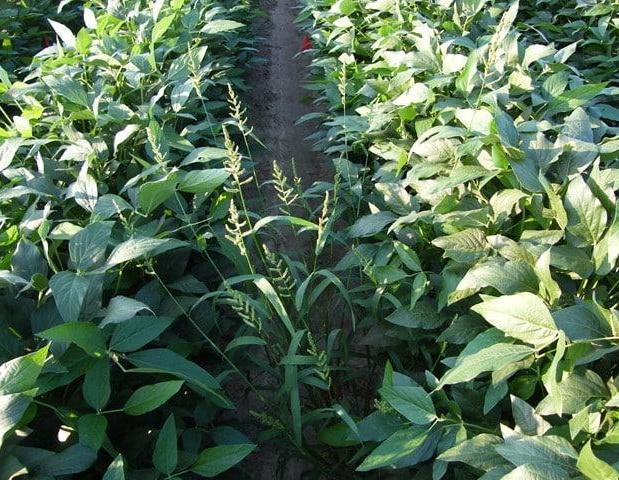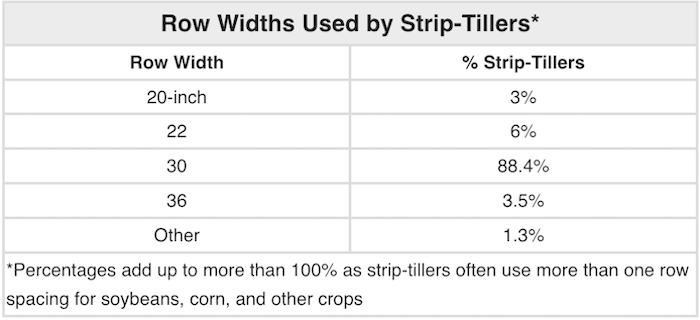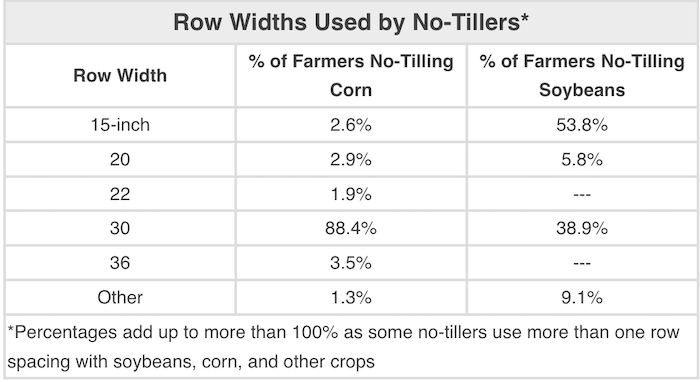.png)
If you can’t easily beat the weeds growing in your no-tilled fields, then you need to come up with a better plan to crowd them out. That’s the wisdom gleaned from a recent weed control analysis on how narrower rows in corn and soybeans impact weed control.
University of Nebraska weed scientist Amit Jhala, graduate student Mandeep Singh and a multi-state team of researchers looked at 35 row spacing vs. weed control studies in 12 states carried out from 1961-2018.
In 64% of the soybean and 24% of the corn studies, narrow rows improved late-season weed control. The researchers came to a pretty clear conclusion: Narrow rows (30 inches or less) suppressed weed density, size (biomass) and weed seed production in both corn and soybeans. Narrowing down the row widths bumped up soybean yields, which was not the case with corn.

Narrow-row soybeans canopy faster, squeezing out light and resources for weedy invaders like barnyard grass. Photo by: Muthu Bagavathiannan, TAMU
Less Space, Fewer Weeds
Within narrow-row soybeans, the density of the weed populations decreased by up to 42%, weed size (or biomass) shrank up to 45% and weed seed production fell by 45%.
Beans growing in fields with 7 1/2-inch rows and multiple applications of herbicides showed the most significant drop in weed seed production. Plus, soybeans grown in narrow rows had 12% higher yields.
Veteran no-tiller and strip-tiller Marion Calmer has conducted detailed on-farm research projects for many years at his Alpha, Ill., operation. A 4-year study produced average soybean yields of 68 bushels with 15-inch rows. This compares with 64 bushel per acre yields with 30-inch rows. With soybean priced at $10 per bushel, Calmer found 15-inch rows were $48 per acre more profitable than beans grown in 30-inch rows.
Narrower rows also provide more time in the spring to manage emerged weeds. The critical time for weed control — when weeds can be removed before they affect yield — comes around the V1 growth stage in wide-row bean fields.
With narrow rows, soybeans also canopy faster, while stealing precious sunlight from weeds growing between the rows.
Jhala says the overall results of this analysis suggest that narrow-row soybeans can potentially be used as an integrated weed management tool, along with herbicides, for managing herbicide-resistant weeds.
Elephants and 60-Inch Corn Rows
While there’s been lots of talk over the past few years about the pros and cons of no-tilling corn in 60-inch rows and interseeding cover crops in the middles, the topic isn’t new to long-term National No-Tillage Conference attendees.
At our 4th conference held in St. Louis in 1996, we had a speaker from South Africa who reported on his experiences with no-tilling corn in 60-inch rows. I don’t remember all the details, but he found yields increased with the wider rows.
The rumor going around that year among conference attendees was that 60-inch corn rows in Africa had gained popularity because the 5-foot row widths allowed elephants to run between the rows without knocking down the valuable corn crop.
Less Light Interception With Corn
Fewer solid conclusions could be drawn for corn, in large part because the researchers only found a half dozen weed control studies that looked at the impact of weed control with narrow-row corn.
Row spacing differences in these studies was less pronounced than in the soybean studies. As a result, there were no meaningful differences in light interception between various corn row spacings.
Calmer says a 5-year study with 20 replications at his farm in Alpha, Ill., showed 30-inch rows produced 196 bushels per acre of corn, compared to 204 bushels per acre with 15-inch rows. With corn priced at $5 per bushel, Calmer says 15-inch rows were $40 per acre more profitable.
Rows wider than 20 inches often require a longer period weed of control due to earlier canopy closure with both corn and soybeans. With wider rows, more light reaches the soil surface, allowing weeds to emerge or regrow later in the growing season. Soybeans grown in 7 ½-10-inch rows in several Corn Belt states had canopy closure that took place 20-30 days earlier than with beans grown in 30-inch rows.
In contrast with narrow-row soybeans, farmers had until the V2-V3 growth stage with corn to control weeds with herbicide passes before the yield loss became permanent.
However, other studies show the dense canopies formed quickly with narrow rows may keep herbicides from reaching growing weeds when chemical application is delayed. Other studies recommend spraying herbicides earlier with row spacings over 30 inches.

Narrow rows with no-tilled corn and soybeans work well with other weed management tactics, such as cover crop residue. Photo by: Teala Ficks








